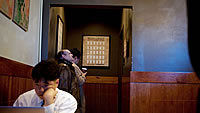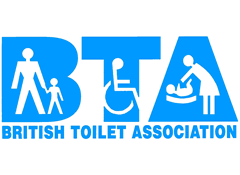British Toilet Association: Archived News from the British Toilet Association
Baristas Lock Restrooms, but the Revolt Doesn’t Last
 Todd Heisler/The New York Times
Todd Heisler/The New York Times
For many workers at Starbucks in New York City, the worst part of their jobs may not be the hordes of demanding tourists. Or the irritation of making ever-more-complex skim Frappuccinos and green tea lattes. Or the unflattering elf hats that some baristas have been asked to wear even before Thanksgiving.
It is having to serve as janitors for the city’s de facto public toilets.
Now, it seems, some of these baristas have had enough.
Tired of customers — and noncustomers — leaving bathrooms messy or worse, they started to lock them at some Starbucks, including one on 45th Street near Avenue of the Americas in Manhattan. Up went signs marked “Employees Only.”
The revolt seemed to reflect a discontent that lurks among the preternaturally cheerful barista corps.
“I have personally cleaned up almost every humanly fluid and plenty that didn’t seem human,” one employee wrote on the StarbucksGossip Web site, coming to a passionate defense of the rebel latte makers.
“I am continually amazed by what people will do when given a few square feet of privacy,” said another. “Why do you want to have sex in a bathroom? I think the toilet would be kind of a mood killer.”
And also, that writer wanted to know, “Why are you drinking beers in there?”
But the mutiny did not go unnoticed. First came news coverage last week that portrayed the company as inhospitable. (Or, as The New York Post put it, “When you gotta go, don’t count on going at Starbucks.”)
Then, in a city with few other options, people reacted as if Starbucks was revoking a public entitlement.
The Gawker blog pronounced New Yorkers “shaken and alarmed.” Between orders for tall, grande and venti cups of coffee, workers across the city fielded questions from the outraged, the worried and the desperate. Finally, Starbucks’ headquarters in Seattle posted a plaintive defense on Twitter: “hey, we’re not closing public bathrooms at all, that’s not true.”
Within days, according to current and former employees who requested anonymity to avoid getting in trouble with the bosses, higher-ups from Starbucks management visited at least two offending shops and ordered them to liberate their restrooms.
The locked lavatories appeared to touch a nerve, exposing the public’s dependence on what is essentially a corporate marketing strategy. Starbucks has long styled its outlets as gathering places where people can sit, use its free Internet access and empty their coffee-filled bladders without being urged to move along.
For years, New Yorkers have awaited the proliferation of self-cleaning pay toilets that City Hall introduced with fanfare in 2005, and again in 2008.
But the public pay toilets have been installed in only three locations. The city’s Transportation Department said it was difficult to identify spots with the required infrastructure — with plumbing but without other utilities that will be disturbed by the installation — and where merchants nearby do not object.
In any case, the city program calls for only 20 toilets over a 20-year period. There are 190 Starbucks outlets in Manhattan.
At the shop on 45th Street, a telltale bare patch on the bathroom door shows where the “Employees Only” sign was removed.
“We had been using it as a locker room,” an employee said, conspiratorially looking around to see who was listening. She explained that the restroom had been closed because a small number of inconsiderate patrons had repeatedly broken the toilet.
On the deserted terrace of a Starbucks at 85th Street and First Avenue one cloudy morning last week, Chris Dalldorf puffed on a cigarette and expounded on the coffee chain’s public service.
“You’re talking to a guy who never drinks Starbucks coffee,” he said. “When I’m drinking coffee, a diner suits me fine.”
“But,” he continued, “I am a habitual user of Starbucks bathrooms.”
Matthew Shakespeare, a shift supervisor there, said he was unconcerned. “I have to use the bathroom, too — and we’re selling coffee!” he said. “There’s no place that the city provides. People get bent out of shape about the smallest things.”
Mr. Shakespeare’s restroom was pristine. But at 87th and Lexington, a more heavily trafficked location, there was evidence that some visitors were less precise in their use of the restroom, and Jesus Diaz, an assistant shift manager there, was less forgiving.
“Starbucks is definitely New York’s public bathroom,” he said, pausing to call out, “Tall peppermint chocolate, whipped cream?” before adding, “It’s a little too much.”
By ANNE BARNARD New York Times
Published: November 22, 2011
A version of this article appeared in print on November 23, 2011, on page A24 of the New York edition with the headline: Baristas Lock Restrooms. Their Revolt Doesn’t Last.
Further information from:
Mike Bone, British Toilet Association
T: +44 (0) 1403 258779
E: enquiries@britloos.co.uk













